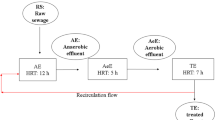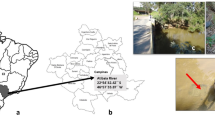Abstract
Detecting pathogenic protozoa in drinking-water treatment sludge is a challenge as existing methods are complex, and unfortunately, there are no specific technical standards to follow. Selecting an efficient analytical method is imperative in developing countries, such as Brazil, in order to evaluate the risk of parasite infection. In this context, three methods to detect Giardia spp. cysts and Cryptosporidium spp. oocysts were tested in sludge generated when water with protozoa and high turbidity was treated. Jar testing was carried out using polyaluminium chloride as a coagulant to generate the residue to be analyzed. The results showed that calcium carbonate flocculation with reduced centrifugation and immunomagnetic separation obtained the highest recoveries in the tested matrix showing 60.2% ± 26.2 for oocysts and 46.1% ± 5 for cysts. The other two methods, the first using the ICN 7× cleaning solution and the second considering the acidification of the sample, both followed by the immunomagnetic separation step, also presented high recoveries showing 41.2% ± 43.3 and 37.9% ± 52.9 for oocysts and 11.5% ± 85.5 and 26% ± 16.3 for cysts, respectively. Evidently, these methods and others should be studied in order to make it possible to detect protozoa in settled residue.

Similar content being viewed by others
References
American Public Health Association – APHA, American Water Works Association – AWWA & Water Environment Federation – WEF. (2012). Standard methods for the examination of water and wastewater. Washington, DC: American Public Health Association.
Andreoli, F. C. & Sabogal-Paz, L. P. (2017). Coagulation, flocculation, dissolved air flotation and filtration in the removal of Giardia spp. and Cryptosporidium spp. from water supply. Environmental Technology. https://doi.org/10.1080/09593330.2017.1400113.
Baldursson, S., & Karanis, P. (2011). Waterborne transmission of protozoan parasites: Review of worldwide outbreaks—an update 2004–2010. Water Research, 45(20), 6603–6614.
Campbell, A. T., Robertson, L. J., Smith, H. V., & Girdwood, R. W. A. (1994). Viability of Cryptosporidium parvum oocysts concentrated by calcium carbonate flocculation. Journal of Applied Bacteriology, 76(6), 638–639.
Chang, C. Y., Huang, C., Pan, J. R., & Wu, B. J. (2007). Modification of immunomagnetic separation procedures for analysis of Cryptosporidium at spiked oocysts and turbid sample conditions. Journal of Environmental Engineering Management, 17(5), 333–338.
De Oliveira, C. M. B. (2012). Determinação de protocolo para detecção de cistos de Giardia spp. e ovos de helmintos, em solos (Determination of a methodology for detection of Giardia spp. cysts and helminth eggs, from soil), Master's thesis, Campinas, Brazil, Universidade Estadual de Campinas (University of Campinas).
Efstratiou, A., Ongerth, J. E., & Karanis, P. (2017a). Waterborne transmission of protozoan parasites: Review of worldwide outbreaks—an update 2011–2016. Water Research, 114, 14–22.
Efstratiou, A., Ongerth, J., & Karanis, P. (2017b). Evolution of monitoring for Giardia and Cryptosporidium in water. Water Research, 123, 96–112.
Feng, Y., Zhao, X., Chen, J., Jin, W., Zhou, X., Li, N., Wang, L., & Xiao, L. (2011). Occurrence, source, and human infection potential of Cryptosporidium and Giardia spp. in source and tap water in Shanghai, China. Applied and Environmental Microbiology, 77(11), 3609–3616.
Franco, R. M. B., Hachich, E. M., Sato, M. I. Z. S., Naveira, R. M. L., Silva, E. D. C., Campos, M. M. D. C., Neto, R. C., Cerqueira, D. A., Branco, N., & Leal, D. A. G. (2012). Performance evaluation of different methodologies for detection of Cryptosporidium spp. and Giardia spp. in water for human consumption to meet the demands of the environmental health surveillance in Brazil. Epidemiologia e Serviços de Saúde (Epidemiology and Health Services), 21(2), 233–242.
Hachich, E. M., Sato, M. I. Z., Galvani, A. T., Menegon, J. R. N., & Mucci, J. L. N. (2004). Giardia and Cryptosporidium in source waters of Sao Paulo state, Brazil. Water Science and Technology, 50(1), 239–245.
IBGE Instituto Brasileiro de Geografia e Estatística (Brazilian Institute of Geography and Statistics). (2010). Pesquisa Nacional de Saneamento Básico (National Survey of Basic Sanitation), Rio de Janeiro, Brazil. https://biblioteca.ibge.gov.br/visualizacao/livros/liv45351.pdf. Accessed 1 July 2018.
Karanis, P., & Kimura, A. (2002). Evaluation of three flocculation methods for the purification of Cryptosporidium parvum oocysts from water samples. Letters in Applied Microbiology, 34(6), 444–449.
Karanis, P., Schoenen, D., & Seitz, H. M. (1996). Giardia and Cryptosporidium in backwash water from rapid sand filters used for drinking water production. Zentralblatt für Bakteriologie, 284(1), 107–114.
Karanis, P., Shoenen, D., & Seitz, H. M. (1998). Distribution and removal of Giardia and Cryptosporidium in water supplies in Germany. Water Science Technology, 37(2), 9–18.
Keegan, A., Daminato, D., Saint, C. P., & Monis, P. T. (2008). Effect of water treatment processes on Cryptosporidium infectivity. Water Research, 42(6), 1805–1811.
Koh, W., Clode, P. L., Monis, P., & Thompson, R. A. (2013). Multiplication of the waterborne pathogen Cryptosporidium parvum in an aquatic biofilm system. Parasites & Vectors, 6(1), 270.
Maciel, P. M. F., & Sabogal-Paz, L. P. (2016). Removal of Giardia spp. and Cryptosporidium spp. from water supply with high turbidity: Analytical challenges and perspectives. Journal of Water and Health, 14(3), 369–378.
Ochiai, Y., Takada, C., & Hosaka, M. (2005). Detection and discrimination of Cryptosporidium parvum and C. hominis in water samples by immunomagnetic separation-PCR. Applied and Environmental Microbiology, 71(2), 898–903.
Olson, M. E., Goh, J., Phillips, M., Guselle, N., & McAllister, T. A. (1999). Giardia cyst and Cryptosporidium oocyst survival in water, soil, and cattle feces. Journal of Environmental Quality, 28(6), 1991–1996.
Rosado-García, F. M., Guerrero-Flórez, M., Karanis, G., Hinojosa, M. D. C., & Karanis, P. (2017). Water-borne protozoa parasites: The Latin American perspective. International Journal of Hygiene and Environmental Health, 220, 783–798.
Sato, M. I. Z., Galvani, A. T., Padula, J. A., Nardocci, A. C., de Souza Lauretto, M., Razzolini, M. T. P., & Hachich, E. M. (2013). Assessing the infection risk of Giardia and Cryptosporidium in public drinking water delivered by surface water systems in Sao Paulo State, Brazil. Science of the Total Environment, 442, 389–396.
Sidhu, J. P., & Toze, S. G. (2009). Human pathogens and their indicators in biosolids: A literature review. Environment International, 35(1), 187–201.
Steinbaum, L., Kwong, L. H., Ercumen, A., Negash, M. S., Lovely, A. J., Njenga, S. M., Boehm, A. B., Pickering, A. J., & Nelson, K. L. (2017). Detecting and enumerating soil-transmitted helminth eggs in soil: New method development and results from field testing in Kenya and Bangladesh. PLoS Neglected Tropical Diseases, 11(4), 1–15.
USEPA. (2012). Method 1623.1 Cryptosporidium and Giardia in Water by Filtration/IMS/FA. U.S. Environmental Protection Agency, Washington, DC, USA. Retrieved from: https://nepis.epa.gov/Exe/ZyPURL.cgi?Dockey=P100J7G4.TXT.
Vesey, G., Slade, J. S., Byrne, M., Shepherd, K., & Fricker, C. R. (1993). A new method for the concentration of Cryptosporidium oocysts from water. Journal of Applied Microbiology, 75(1), 82–86.
Walker, M. J., Montemagno, C. D., & Jenkins, M. B. (1998). Source water assessment and nonpoint sources of acutely toxic contaminants: A review of research related to survival and transport of Cryptosporidium parvum. Water Resources Research, 34(12), 3383–3392.
Funding
The authors are supported by the São Paulo Research Foundation (FAPESP) (Process 2012/50522-0) and the Global Challenges Research Fund (GCRF) UK Research and Innovation (SAFEWATER, EPSRC Grant Reference EP/P032427/1) for the research support. Master’s scholarship was awarded to Guilherme Lelis Giglio (Finance Code 001) from the Coordination for the Improvement of Higher Education Personnel (CAPES-PROEX).
Author information
Authors and Affiliations
Corresponding author
Ethics declarations
Conflict of interest
Authors hereby declare previous originality check, and no conflict of interest and open access to the repository of data used in this paper for scientific purposes.
Rights and permissions
About this article
Cite this article
Giglio, G.L., Sabogal-Paz, L.P. Performance comparison of three methods for detection of Giardia spp. cysts and Cryptosporidium spp. oocysts in drinking-water treatment sludge. Environ Monit Assess 190, 686 (2018). https://doi.org/10.1007/s10661-018-7057-9
Received:
Accepted:
Published:
DOI: https://doi.org/10.1007/s10661-018-7057-9




